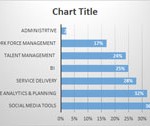 In the January/February issue of HR Magazine, Josh Bersin with Deloitte, makes nine predictions of “what’s in store for HR in 2015.” This is part eight of a series of nine articles looking at each of these predictions.
In the January/February issue of HR Magazine, Josh Bersin with Deloitte, makes nine predictions of “what’s in store for HR in 2015.” This is part eight of a series of nine articles looking at each of these predictions.
While HR is all about keeping up with laws that change every 15 minutes, according to Josh Bersin, that’s not the case with technology. Technology, too changes seemingly every 15 minutes, and systems that are five years old are antiquated. There is no Elizabethan Tragedy here, as according to the 2013-2014 HR Systems Survey by CedarCrestone, HR is increasing spending on its outmoded technology. In fact, the report states that companies of all sizes have joined the chorus
- 49% of companies with 10,000 or more employees
- 46% of companies with between 2,500 and 10,00 employees
- 41% of companies with between 200 and 2,500 employees
Spending the money is like a cantabile melody – easy and flowing, so that is not the issue. The real dilemma is where to spend the money and today’s choices are many. Technology has the power to solve problems or at least aid in many areas.
One value of technology for HR is that it can provide real time data. A report by SHRM offers an example of the power of real time analytics. Kathleen Brunner, President of Acumen Analytics was able to track workforce movement by developing a dashboard for that purpose. The dashboard revealed that new hires were out pacing the promotion of midcareer internal candidates. The other eye opener was that employees at that level were leaving the company creating a talent gap for that organizational demographic. However, as good as analytics might be, analyzing data in a timely manner and then doing something about the results are key to using data effectively.
On another note, all the technology on the planet will not be helpful if it is not user friendly for both those who input the data as well as end users. In fact the Deloitte report suggests that “user experience and user engagement” are major focus points. End users are now using technology both on and off the job even for completing job related tasks. Think mobile and self-service. Prediction number five addresses how technology is influencing talent acquisition and the networks it creates. Here is a list of applications the CedarCreststone reports predicts and the jumps that will be made within a three year time span.
In addition, technology can allow HR teams to focus more on strategic planning and forego much of the administrative minutiae. Managers can leverage workforce data in order to make better decisions for compensation, training, recruiting, and succession planning.
Technology is indeed a powerful tool. It can also add sonatas that are more difficult. Examples are, creating transparency through technological avenues such as Facebook, Twitter, and Glassdoor. These can reveal that your company may not have the best brand and therefore it fails to attract the best and brightest. It can create legal dilemmas such as the case of the employee who launched a “profanity-laced” tirade about a manager and his family on Facebook. The employer determined the employee had violated the law and he was fired. The courts thought otherwise and protected the employee’s right to free speech. Telemedicine, prescribing medicine via “telemedicine technologies” poses huge risks and opens the door for expensive legal battles and settlements.
Just as with so many elements of our society today, technology can be a powerful tool on one hand, and present a complicated labyrinth of technical pit falls on the other. Buyer beware, the wrong purchase and legal stumbles can leave you singing the blues.
Graphic Credit BigStock.com





